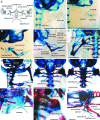Transformation of the pectoral girdle in the evolutionary origin of frogs: insights from the primitive anuran Discoglossus
- PMID: 16822264
- PMCID: PMC2100309
- DOI: 10.1111/j.1469-7580.2006.00583.x
Transformation of the pectoral girdle in the evolutionary origin of frogs: insights from the primitive anuran Discoglossus
Abstract
Using cleared-and-stained whole mounts and computer-aided three-dimensional reconstructions made from serial histological sections, we studied the development of the pectoral girdle in Discoglossus pictus, an extant member of an ancient frog lineage, represented for example by Eodiscoglossus from the Middle Jurassic to Early Cretaceous periods in Europe. Basic developmental features were compared with those of extinct Temnospondyli, considered to be the most probable anuran ancestors, and with Triadobatrachus, an early Triassic proanuran. In the endochondral girdle, the separate scapula and coracoid of Discoglossus and other anurans (completed by suprascapular and procoracoid cartilages) evolved from the compact scapulocoracoid of temnospondyls by paedomorphosis. In parallel, the dermal ossifications of the girdle were reduced to a small clavicle and cleithrum. The overall reduction in ossification of the anuran pectoral girdle supports the hypothesis of a paedomorphic origin for Anura. The almost simultaneous appearance of dermal and endochondral ossifications may be explained by the accumulation of developmental events during a short, distinct metamorphosis (which did not occur in neotenic temnospondyls living permanently in water). The sternal elements seem to be neomorphs for the most part, which help to cushion the shock of landing in jumping anurans but which also evolved as functional substitutes (insertion area for the pectoralis muscles) of the temnospondyl interclavicle.
Figures



Similar articles
-
Growth of the pectoral girdle of the Leopard frog, Rana pipiens (Anura: Ranidae).J Morphol. 2005 Apr;264(1):94-104. doi: 10.1002/jmor.10322. J Morphol. 2005. PMID: 15744727
-
Development of the pelvis and posterior part of the vertebral column in the Anura.J Anat. 2005 Jan;206(1):17-35. doi: 10.1111/j.0021-8782.2005.00366.x. J Anat. 2005. PMID: 15679868 Free PMC article.
-
On the homology of the shoulder girdle in turtles.J Exp Zool B Mol Dev Evol. 2015 May;324(3):244-54. doi: 10.1002/jez.b.22584. Epub 2014 Jul 23. J Exp Zool B Mol Dev Evol. 2015. PMID: 25052382 Review.
-
To be or not to be heavier: The role of dermal bones in the buoyancy of the Late Triassic temnospondyl amphibian Metoposaurus krasiejowensis.J Anat. 2022 Dec;241(6):1459-1476. doi: 10.1111/joa.13755. Epub 2022 Sep 27. J Anat. 2022. PMID: 36165276 Free PMC article.
-
The evolution of larvae in temnospondyls and the stepwise origin of amphibian metamorphosis.Biol Rev Camb Philos Soc. 2024 Oct;99(5):1613-1637. doi: 10.1111/brv.13084. Epub 2024 Apr 10. Biol Rev Camb Philos Soc. 2024. PMID: 38599802 Review.
Cited by
-
Morphology and function of the forelimb in arboreal frogs: specializations for grasping ability?J Anat. 2008 Sep;213(3):296-307. doi: 10.1111/j.1469-7580.2008.00929.x. Epub 2008 Jun 19. J Anat. 2008. PMID: 18565111 Free PMC article.
-
The oldest tadpole reveals evolutionary stability of the anuran life cycle.Nature. 2024 Dec;636(8041):138-142. doi: 10.1038/s41586-024-08055-y. Epub 2024 Oct 30. Nature. 2024. PMID: 39478214
References
-
- Alberch P, Gould SJ, Oster GF, Wake DB. Size and shape in ontogeny and phylogeny. Paleobiology. 1979;5:296–317.
-
- Baleeva NV. Formation of the scapular part of the pectoral girdle in anuran larvae. Russ J Herpetol. 2001;8:195–204.
-
- Borsuk-Białynicka M, Evans SE. The scapulocoracoid of an early Triassic stem-frog from Poland. Acta Palaeontol Pol. 2002;47:79–96.
-
- Boy JA. Die Larven der rhachitomen Amphibien (Amphibia: Temnospondyli; Karbon – Trias) Paläont Z. 1974;48:236–268.
-
- Boy JA, Sues H-D. Branchiosaurs: larvae, metamorphosis and heterochrony in temnospondyls and seymouriamorphs. In: Heatwole H, Carroll E, editors. Amphibian Biology, Vol. 4.– Paleontology. Chipping Norton: Surrey Beatty & Sons; 2000. pp. 1150–1197.
Publication types
MeSH terms
LinkOut - more resources
Full Text Sources

